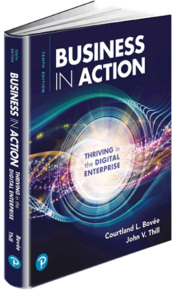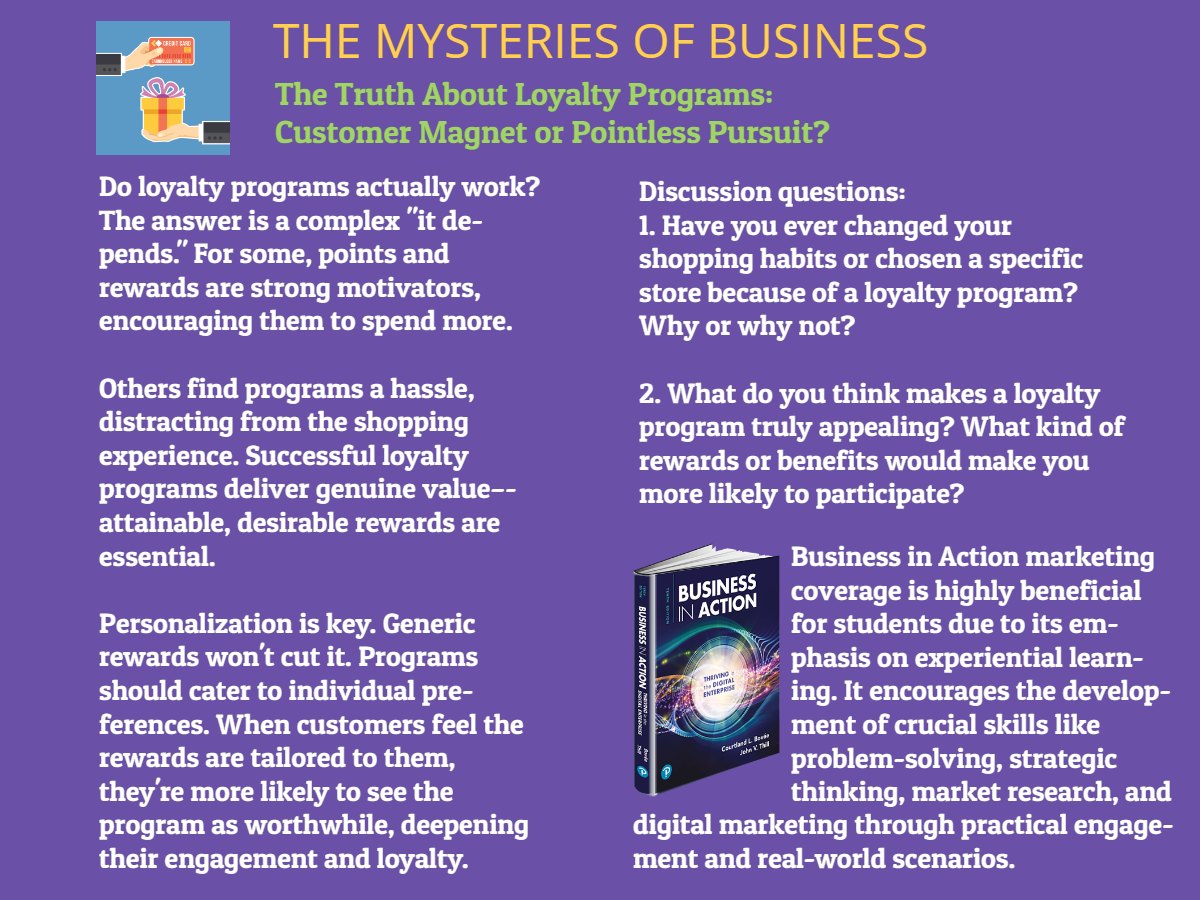
Introduction to Business Textbooks
Learn about the new leader in the field and the most current text on the market that
includes easy-to-understand coverage of artificial intelligence. Read More
Overcoming the Top 10 Challenges Faced by Introduction to Business Instructors
 Teaching an Introduction to Business course can be both rewarding and challenging. Instructors must navigate various obstacles to effectively engage students and deliver a comprehensive understanding of the business world. In this article, we will explore the ten great challenges faced by Introduction to Business instructors and provide specific suggestions for overcoming these challenges.
Teaching an Introduction to Business course can be both rewarding and challenging. Instructors must navigate various obstacles to effectively engage students and deliver a comprehensive understanding of the business world. In this article, we will explore the ten great challenges faced by Introduction to Business instructors and provide specific suggestions for overcoming these challenges.
Diverse student backgrounds: Challenge: Students come from various backgrounds, with different levels of business knowledge and experience. Solution: Conduct a pre-course survey to assess students' backgrounds and tailor the course content accordingly. Provide additional resources and support for students who may need extra help.
Keeping content up-to-date: Challenge: The business world is constantly evolving, and course material can quickly become outdated. Solution: Regularly update course content to include current events, case studies, and emerging trends. Encourage students to share relevant news articles and discuss their implications in class.
Balancing theory and practice: Challenge: Striking the right balance between theoretical concepts and practical applications can be difficult. Solution: Incorporate real-world examples, guest speakers, and case studies to demonstrate how theories apply in practice. Assign projects that allow students to apply their knowledge to real business scenarios.
Engaging students in online courses: Challenge: Keeping students engaged and motivated in online courses can be challenging. Solution: Use interactive elements such as discussion forums, live Q&A sessions, and group projects to foster engagement. Provide timely feedback and encourage student participation.
Addressing different learning styles: Challenge: Students have different learning preferences, such as visual, auditory, or kinesthetic. Solution: Incorporate a variety of teaching methods, including lectures, discussions, videos, and hands-on activities, to cater to different learning styles.
Integrating technology: Challenge: Incorporating technology into the classroom can be daunting for some instructors. Solution: Attend workshops or seek guidance from colleagues to learn about effective digital tools and platforms. Start with simple technologies and gradually introduce more advanced ones as comfort levels increase.
Developing critical thinking skills: Challenge: Encouraging students to think critically and analyze business problems can be challenging. Solution: Use case studies, debates, and problem-based learning activities to promote critical thinking. Encourage students to question assumptions and consider multiple perspectives.
Addressing ethical concerns: Challenge: Discussing ethical issues in business can be sensitive and controversial. Solution: Establish a safe and respectful classroom environment for discussing ethical dilemmas. Use real-world examples and case studies to illustrate the importance of ethical decision-making in business.
Providing individualized attention: Challenge: Giving each student individualized attention can be difficult in large classes. Solution: Offer office hours, encourage peer-to-peer learning, and use online discussion forums to provide additional support. Consider using teaching assistants or dividing the class into smaller discussion groups.
Assessing student learning: Challenge: Evaluating student learning and providing meaningful feedback can be time-consuming. Solution: Use a variety of assessment methods, such as quizzes, projects, and presentations, to gauge student understanding. Provide clear grading rubrics and timely feedback to help students improve their performance.
Teaching an Introduction to Business course presents unique challenges, but with the right strategies and tools, instructors can overcome these obstacles and provide a valuable learning experience for their students. By staying current, engaging students, addressing diverse learning needs, and fostering critical thinking skills, instructors can effectively guide students through the fascinating world of business.
 How Business in Action Helps Instructors Overcome the Top 10 Challenges
How Business in Action Helps Instructors Overcome the Top 10 Challenges
Business in Action is a comprehensive and engaging Introduction to Business textbook that provides instructors with the tools and resources to effectively address the challenges they face in the classroom. This article will explore how Business in Action helps instructors overcome the top 10 challenges mentioned in the previous article.
Diverse student backgrounds: Business in Action offers a clear and accessible writing style that caters to students from various backgrounds. The textbook provides a solid foundation of business concepts, making it easier for instructors to bridge knowledge gaps and ensure all students are on the same page.
Keeping content up-to-date: Business in Action is regularly updated to include the latest business trends, case studies, and real-world examples. The textbook's online resources, such as the MyLab Intro to Business platform, provide instructors with access to current articles, videos, and other supplementary materials.
Balancing theory and practice: Business in Action strikes an optimal balance between theoretical concepts and practical applications. Each chapter includes real-world examples, case studies, and practical exercises that help students understand how business theories apply in practice.
Engaging students in online courses: The MyLab Intro to Business platform, which complements Business in Action, offers a range of interactive features, such as simulations, videos, and adaptive learning tools. These resources help instructors keep students engaged and motivated, even in online course settings.
Addressing different learning styles: Business in Action caters to different learning styles by incorporating a variety of pedagogical elements, such as visual aids, infographics, and hands-on activities. The textbook's online resources also provide instructors with additional multimedia content to support various learning preferences.
Integrating technology: Business in Action seamlessly integrates technology through the MyLab Intro to Business platform. This platform offers a user-friendly interface, making it easy for instructors to incorporate digital tools and resources into their courses.
Developing critical thinking skills: Business in Action emphasizes the importance of critical thinking throughout the textbook. Each chapter includes thought-provoking questions, case studies, and problem-solving exercises that encourage students to analyze business issues from multiple perspectives.
Addressing ethical concerns: Business in Action dedicates an entire chapter to business ethics and corporate social responsibility. The textbook presents ethical dilemmas and real-world examples to help instructors facilitate meaningful discussions and promote ethical decision-making in business.
Providing individualized attention: The MyLab Intro to Business platform offers personalized learning paths and adaptive study plans that help instructors provide individualized attention to each student. The platform's gradebook and reporting features also make it easier for instructors to monitor student progress and provide targeted support.
Assessing student learning: Business in Action provides a range of assessment tools, including end-of-chapter quizzes, test banks, and project ideas. The MyLab Intro to Business platform also offers automated grading and immediate feedback, saving instructors time and helping students track their progress.
Business in Action is an ideal textbook for Introduction to Business courses, as it effectively addresses the top 10 challenges faced by instructors. By providing up-to-date content, engaging pedagogical elements, and seamless technology integration, Business in Action empowers instructors to create a dynamic and effective learning experience for their students.
Read moreThe Truth about Loyalty Programs: Customer Magnet or Pointless Pursuit?

Here are my answers to the discussion questions:
- Have you ever changed your shopping habits or chosen a specific store because of a loyalty program? Why or why not?
Yes, I have changed my shopping habits and chosen specific stores because of their loyalty programs. For example, I frequently shop at a particular grocery store chain because of their rewards program, which offers points for every dollar spent that can be redeemed for discounts on gas or future purchases. I find this program valuable because the rewards are easy to earn and redeem, and they provide tangible savings on products I would buy anyway.
However, I have also avoided certain loyalty programs that felt too complicated or didn't offer rewards that were meaningful to me. I once signed up for a clothing store's loyalty program but never used it because the points system was confusing and the rewards didn't align with my shopping preferences.
- What do you think makes a loyalty program truly appealing? What kind of rewards or benefits would make you more likely to participate?
For me, a truly appealing loyalty program is one that offers:
- Simplicity: The program should be easy to understand and use, with clear rules for earning and redeeming rewards. Complicated points systems or excessive restrictions can be frustrating and discourage participation.
- Relevant rewards: The rewards offered should be things that I actually want or need. Discounts on products I regularly buy, exclusive access to sales or products, or even personalized recommendations based on my shopping history would all be appealing incentives.
- Attainable rewards: The rewards should feel achievable within a reasonable timeframe. If it takes an extremely long time or an unrealistic spending amount to earn a meaningful reward, I'm less likely to engage with the program.
- Flexibility: I appreciate loyalty programs that offer multiple ways to earn and redeem rewards, such as earning points through purchases, referrals, or engaging with the brand on social media, and the ability to choose from various reward options.
- Integration with my shopping experience: A loyalty program that seamlessly integrates with my typical shopping experience, such as a mobile app that tracks my points and offers personalized deals, would make me more likely to participate consistently.
Ultimately, a loyalty program that demonstrates a genuine understanding of my preferences and offers value that enhances my shopping experience would be most appealing and effective in securing my ongoing business.
 Business in Action is the ideal choice for any Introduction to Business instructor seeking to provide their students with a comprehensive, engaging, and practical learning experience. This textbook stands out for its clear and accessible writing style, which effectively explains complex business concepts in a way that resonates with students from diverse backgrounds. The content is carefully organized and updated to reflect the latest trends and challenges in the dynamic world of business, ensuring that students gain relevant and applicable knowledge.
Business in Action is the ideal choice for any Introduction to Business instructor seeking to provide their students with a comprehensive, engaging, and practical learning experience. This textbook stands out for its clear and accessible writing style, which effectively explains complex business concepts in a way that resonates with students from diverse backgrounds. The content is carefully organized and updated to reflect the latest trends and challenges in the dynamic world of business, ensuring that students gain relevant and applicable knowledge.
With its rich array of real-world examples, case studies, and practical applications, Business in Action helps students bridge the gap between theory and practice, fostering critical thinking, problem-solving, and decision-making skills that are essential for success in today's competitive business landscape. Moreover, the textbook's robust suite of supplementary materials, including online resources, such as the powerful MyLab (now supported by artificial intelligence), and interactive learning tools, enhances student engagement and supports various teaching styles. By choosing Business in Action, instructors can be confident that they are providing their students with a solid foundation for understanding the multifaceted nature of business and preparing them for the challenges and opportunities that await them in their future careers.
Read more
The Hyperlocal Uprising Reshaping Retail

Discussion Questions about the Hyperlocal Hustle Reshaping Retail:
1. How can local businesses leverage the "hyperlocal hustle" to compete with larger chains and online retailers?
Answer:
The hyperlocal hustle presents unique opportunities for local businesses to thrive:
Community focus: Build strong relationships with local customers by understanding their needs and preferences. Offer products and services specifically tailored to the community. Host events and initiatives that foster a sense of belonging.
Direct-to-consumer: Utilize online platforms and social media to connect directly with customers, bypassing middlemen and reducing costs. Offer delivery, pickup, and subscription options for convenience.
Experiential retail: Create a unique and engaging shopping experience that larger chains lack. Offer personalized service, workshops, tastings, or other interactive elements. Highlight the human connection and local stories behind your products.
Partnerships: Collaborate with other local businesses for cross-promotion, joint events, or shared resources. This strengthens the local ecosystem and attracts more customers.
Agility and innovation: Be adaptable to changing trends and customer preferences. Experiment with new ideas and embrace technology to improve efficiency and reach.
2. What are the potential challenges and drawbacks of the hyperlocal hustle for consumers and businesses alike?
Answer:
While the hyperlocal movement holds promise, there are potential challenges to consider:
Limited selection: Smaller stores may not have the same variety of products as larger chains.
Price competition: Local businesses may struggle to compete on price with national brands with economies of scale.
Marketing reach: Reaching a wider audience can be difficult without significant marketing resources.
Technological adoption: Implementing online platforms, delivery systems, and other tech solutions can require investment and expertise.
Consumer trust: Building trust and brand recognition takes time and effort, especially for new businesses.
For consumers, the drawbacks might include:
Higher prices: Supporting local businesses often comes at a premium compared to mass-produced goods.
Limited availability: Certain products or services may not be available locally.
Convenience: Shopping at multiple local stores can be less convenient than a one-stop shop at a larger chain.
Overall, the hyperlocal hustle presents an exciting opportunity for both businesses and consumers, but careful consideration of the challenges is crucial for long-term success.
Read moreTeach the Four Ways Artificial Intelligence Is Changing Business
 "Artificial intelligence's impact on the world is momentous, yet it can feel almost invisible at the same time. Consider modern conveniences like Netflix recommendations, Facebook's suggested articles, and even Google's search page. These are all the result of AI, and they've become so ingrained in peoples' daily lives that they are almost unnoticed."
"Artificial intelligence's impact on the world is momentous, yet it can feel almost invisible at the same time. Consider modern conveniences like Netflix recommendations, Facebook's suggested articles, and even Google's search page. These are all the result of AI, and they've become so ingrained in peoples' daily lives that they are almost unnoticed."
A Personal Note to Introduction to Business Instructors
 Please read this personal note to all Introduction to Business instructors.
Please read this personal note to all Introduction to Business instructors.
A Personal Message from Court Bovee and John Thill
 As educators, we pride ourselves on preparing students for the opportunities they will encounter in their careers. This has never been an easy goal with the introduction to business course, given the wide range of topics it needs to address, and the challenge gets more daunting every year as the business world continues to evolve and grow more complex.
As educators, we pride ourselves on preparing students for the opportunities they will encounter in their careers. This has never been an easy goal with the introduction to business course, given the wide range of topics it needs to address, and the challenge gets more daunting every year as the business world continues to evolve and grow more complex.
How do you stay on top of all the changes taking place—particularly if you have limited prep time?
Helping you meet this challenge has always been the driving force behind Business in Action. To prepare the Ninth Edition, we studied every aspect of business, from retailing to finance, to identify the forces and trends that are reshaping the way business works. Here’s a quick look at some of the biggest changes we’re seeing. For some of these, Business in Action is the only text you’ll find that covers them in a meaningful way.
The digital transformation is reshaping every functional area in business, and more than three-quarters of executives say that digital technology will have a “major” or “transformative” impact on their industries. Alert companies are scrambling to reinvent themselves by implementing new business models or optimizing existing approaches. Business in Action is the only leading textbook in this market that helps students appreciate the full scope of this transformation. In fact, our theme for the Ninth Edition is “Thriving in the Digital Enterprise,” and this concept informs the entire text.
Financial services are a great example of how digital technologies are disrupting one sector after another. Did you know that more than 10,000 companies are now active in the fintech arena? We introduce students to five major benefits that fintech is starting to produce, from making financial services more inclusive to enhancing financial decision-making with robo advisors and other artificial intelligence (AI) tools.
The field of marketing has changed so much in recent years that is scarcely recognizable from the old days of the “Four Ps.” The innovations we cover in Business in Action include involving the customer in the marketing process with efforts such as voice of the customer programs, making data-driven marketing decisions (including the all-important challenge of attribution in ad spending), marketing with greater concern for ethics and etiquette, and creating satisfying customer experiences (including creating customer experience touchpoints and the growing practice of social customer care).
Perhaps no aspect of marketing is undergoing as much disruption as the retailing sector. We introduce students to the challenging economics of retailing; discuss how innovations such as mobile commerce, social commerce, and subscription shopping are changing consumer behavior; and take a clear look at the facts and myths of the “retail apocalypse.”
Even as all these changes are happening in the external business environment, many companies are taking a fresh look at what kinds of organizations they want to be and even what it means to be a company. Business in Action explores such topical issues as workplace negativity, safe workspaces, inclusive workplaces and opportunities, the evolving role of HR, the gig economy, and unstructured organizations that rely on social networks and virtual communities.
Sadly, not all recent developments in the business world are positive, of course. The last few years have witnessed stunning ethical meltdowns by some of the biggest companies in the world. The Ninth Edition takes an unflinching look at these lapses and identifies three primary causes of unethical behavior that students need to be aware of: management pressure and corporate culture, a willful blindness to harm, and a sense of ethical and even legal impunity bred in part by the Silicon Valley mentality of “move fast and break things.”
To those of you who already rely on Business in Action to provide your students with the latest coverage of the dynamic field of business, we extend our sincere thanks and continued wishes for success. If you haven’t explored this text yet, we invite you to take a look at its pedagogical features, the range of up-to-date topics it covers, and the value it offers your students. Here’s a video preview and in-depth information about Ninth Edition. We invite you to order a complimentary examination copy today.
Respectfully,
Court Bovee
John Thill
P.S. You might enjoy some of the posts on our Teaching Introduction to Business Blog, too.
Read the full article:
 Business in Action, 10th Edition
Business in Action, 10th Edition